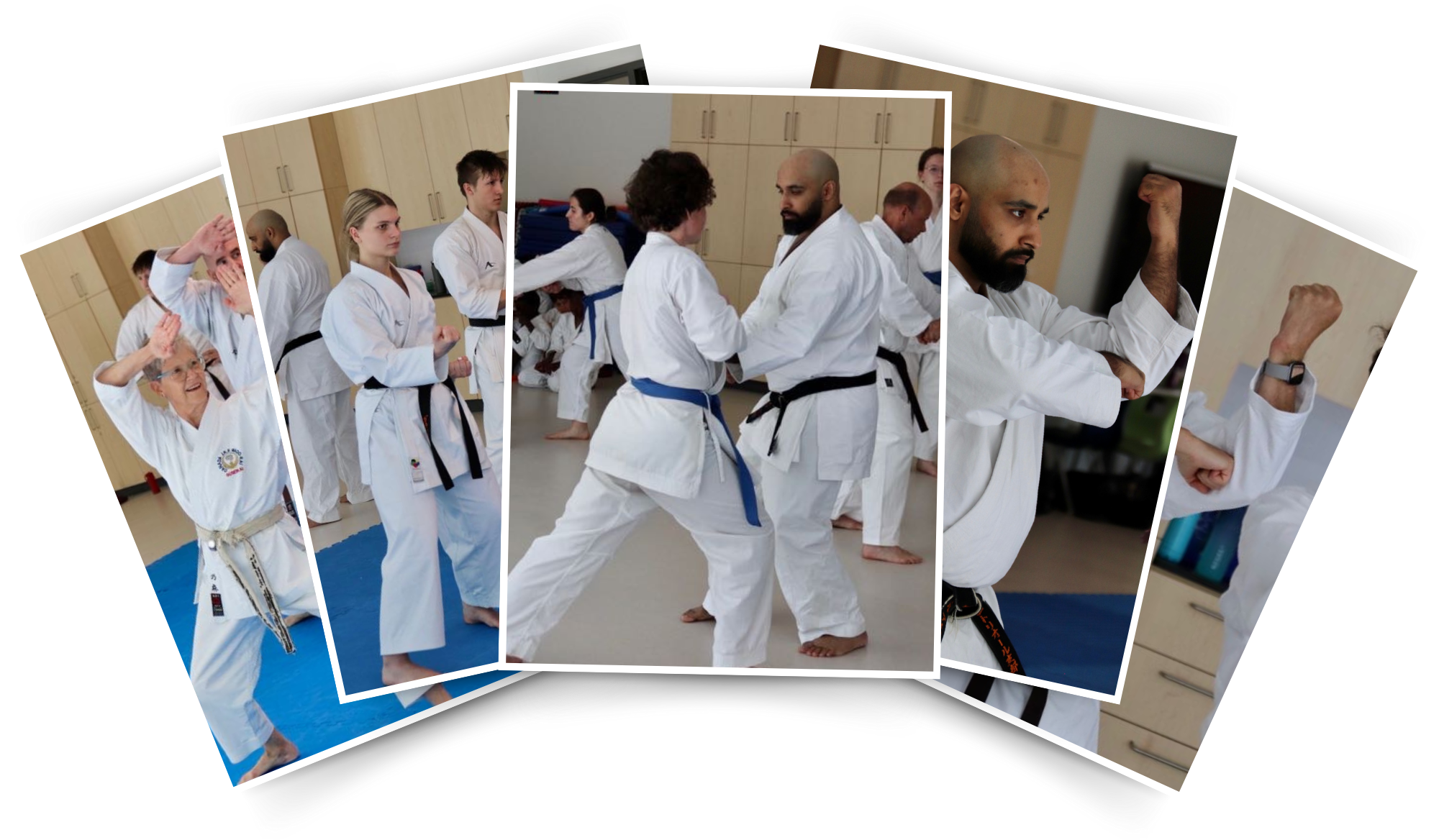Kata & Kumite

Kata are predefined, specific patterns of movement that incorporate and encapsulate martial techniques, concepts, and applications. The exact movements of a kata often vary from one organization to another, and even from one school to another within the same organization. The variations can range from gross deviations apparent to the untrained observer to very subtle minutiae. In his 1977 book on Wadō-ryū (published in English in 1997), Ōtsuka Sensei declared only nine official kata for Wadō-ryū: Pinan Shodan, Pinan Nidan, Pinan Sandan, Pinan Yondan, Pinan Godan, Kūsankū, Naihanchi, Chintō, and Seishan. Within his text, Ōtsuka Sensei provides detailed notes on the performance of these kata, which has resulted in less deviation across organizations on their performance. However, Ōtsuka Sensei did teach other kata. Perhaps because Ōtsuka Sensei did not provide specific notes for the performance of other kata in his text, there is greater variation in these other kata across organizations and schools.
Kata
Click on the highlighted text to view instructional videos. The following videos are provided as training aids and resource information supporting the instruction of Club Leads. The videos are approved by the CZWKA Technical Committee.
- Pinan kata: created by Ankō Itosu, and consisting of Pinan Shodan (平安初段), Pinan Nidan (平安二段), Pinan Sandan (平安三段), Pinan Yodan (平安四段), and Pinan Godan (平安五段).
- Bassai (披塞; also known as Passai): a Tomari-te kata that uses dynamic stances and hip rotation.
- Chintō: formulated by Matsumura Sōkon from the teachings of a sailor or pirate named Chintō (or Annan, depending on the source). Crane stance occurs many times, and the flying kicks differentiate Chintō from other kata. Chinto 360 View
- Jihon : A Tomari-te kata; part of the Jion kata group.
- Jitte : another Tomari-te kata of the Jion kata group; the name means “10 hands.”
- Kushanku: “Sky Viewing”. Kūsankū was the Okinawan name for Kwang Shang Fu, a Sapposhi (emissary of China’s ruling class) sent to Okinawa in the 18th century. This kata uses stances and attacks comprising of the five previous Pinan kata.
- Naihanchi (内畔戦; also known as Naifanchi): this was the original name for the three Tekki kata, but was changed by Funakoshi. This is a lateral kata learned from Chōki Motobu. Wadō-ryū practices only the first Naihanchi kata.
- Niseishi (二十四步): the name means “24 steps.” Transmitted by Ankichi Aragaki, this kata is known in Japanese as Nijūshiho.
- Rōhai: Rōhai has three variation invented by Itosu. Wadō-ryū practices Rōhai Shodan.
- Seishan: the name means “13 hands.” This kata was named after a well-known Chinese martial artist who lived in or near Shuri c. 1700. The movements are repeated in sets of three, and has pivots and turning of the head. Seishan 30 View
- Wanshu: the name means “flying swallow.” This is a Tomari-te kata based on movements brought to Okinawa in 1683 by a Chinese envoy of the same name. The metaphorical name, “Flying Swallows,” comes from the soft blocking sequences near the end of this kata.
Kata Demonstration of Historical Significance
The following are historical examples of JKF Wado Kai Kata as demonstrated by renowned sensei, all of which were over the age of 50 at the time of recording.
Yakusoku or Kihon Kumite
In addition to the solo kata listed above, many Wadō-ryū schools also practice paired kata, which reflects its jujutsu heritage. These paired kata are performed by two people (one as the attacker and one as the defender), demonstrating a range of self-defense techniques. The paired kata of Wadō-ryū often vary from one organization from another, because Ōtsuka did not standardize them. The paired kata are:
- Yakusoku Kumite: 10 prearranged offensive and defensive combinations derived from Shindo Yoshin Ryu Jujitsu.
- Kumite Gata: consists of 10 – 24 varietal techniques (depending on the organization) of attack emphasizing Katamae (pinning) and Kuzushi (breaking balance) and multiple strikes.
- Ohyo Kumite: consists of various techniques of attack, incorporating Karate blocks, kicks and strikes with jujutsu throws and body movements. This is a specialty of Tatsuo Suzuki Hanshi’s W.I.K.F organization.
- Idori: Seated offensive and defensive combinations derived from Shindo Yoshin Ryu Jujitsu.
- Tanto Dori: Knife defense Offensive and defensive combinations derived from Shindo Yoshin Ryu Jujitsu .
- Shinken Shirahadori (真剣白刃取り): consists of 5-10 (depending on organization) techniques of defenses against sword attacks, influenced by jujutsu body movements, throwing, and joint-locking techniques.
About Wado Kumite
Kumite (組手) is the sparring aspect of karate and it covers a vast range of activities and practices. Beginners will start by practicing the Kihon Kumite, which can be imagined as choreographed “fights.” The patterns and motions are set, and practitioners will train their speed, accuracy, and timing as if they were in a real sparring match. As a karate student progresses they begin Jiyu Kumite (自由組手) or “free sparring.” These are the matches seen in high level competition between two karate practitioners that are scored. Jiyu Kumite looks more like a real “fight” as there is no set movement, each athlete is trying their best to score points on their opponent.
Kihon Kumite
Kihon (基本, きほん) means “basics” or “fundamentals.” The term is used to refer to the basic techniques that are taught and practiced as the foundation of most martial arts, including Wado Ryu Karate.
The practice and mastery of kihon is essential to all advanced training, and includes the practice of correct body form and breathing, while practicing basics such as stances, punches, kicks, blocks, and thrusts.
Kihon techniques tend to be practiced often, in many cases during each practice session. They are considered fundamental to mastery and improvement of all movements of greater complexity. There are 10 Kihon Kumites that are practised by Wadokai Practitioners and they are:
Video Examples
JKF Wado Kai Kihon Kumite – Historic Examples
The following are historical examples of JKF Wado Kai Kihon Kumite as demonstrated by renowned sensei, all of which were over the age of 50 at the time of recording
(Click on any of the Kihon Kumite names above to load an instructional video.)

